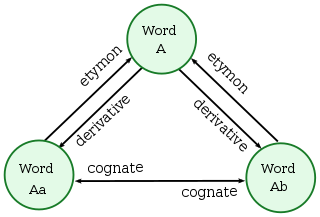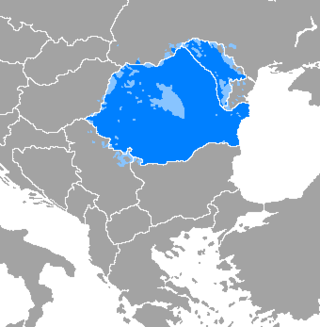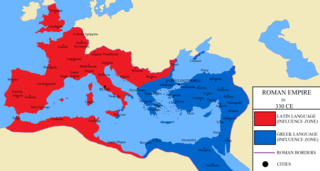Related Research Articles

In historical linguistics, cognates or lexical cognates are sets of words that have been inherited in direct descent from an etymological ancestor in a common parent language. Because language change can have radical effects on both the sound and the meaning of a word, cognates may not be obvious, and it often takes rigorous study of historical sources and the application of the comparative method to establish whether lexemes are cognate. Cognates are distinguished from loanwords, where a word has been borrowed from another language.

In linguistics, the comparative method is a technique for studying the development of languages by performing a feature-by-feature comparison of two or more languages with common descent from a shared ancestor and then extrapolating backwards to infer the properties of that ancestor. The comparative method may be contrasted with the method of internal reconstruction in which the internal development of a single language is inferred by the analysis of features within that language. Ordinarily, both methods are used together to reconstruct prehistoric phases of languages; to fill in gaps in the historical record of a language; to discover the development of phonological, morphological and other linguistic systems and to confirm or to refute hypothesised relationships between languages.

The Indo-European languages are a language family native to the overwhelming majority of Europe, the Iranian plateau, and the northern Indian subcontinent. Some European languages of this family—English, French, Portuguese, Russian, Dutch, and Spanish—have expanded through colonialism in the modern period and are now spoken across several continents. The Indo-European family is divided into several branches or sub-families, of which there are eight groups with languages still alive today: Albanian, Armenian, Balto-Slavic, Celtic, Germanic, Hellenic, Indo-Iranian, and Italic; another nine subdivisions are now extinct.

A language family is a group of languages related through descent from a common ancestral language or parental language, called the proto-language of that family. The term "family" reflects the tree model of language origination in historical linguistics, which makes use of a metaphor comparing languages to people in a biological family tree, or in a subsequent modification, to species in a phylogenetic tree of evolutionary taxonomy. Linguists therefore describe the daughter languages within a language family as being genetically related. The divergence of a proto-language into daughter languages typically occurs through geographical separation, with different regional dialects of the proto-language spoken by different speech communities undergoing different language changes and thus becoming distinct languages from each other.

The Romance languages, also known as the Latin or Neo-Latin languages, are the languages that are directly descended from Vulgar Latin. They are the only extant subgroup of the Italic branch of the Indo-European language family.

Romanian is the official and main language of Romania and Moldova. Romanian is part of the Eastern Romance sub-branch of Romance languages, a linguistic group that evolved from several dialects of Vulgar Latin which separated from the Western Romance languages in the course of the period from the 5th to the 8th centuries. To distinguish it within the Eastern Romance languages, in comparative linguistics it is called Daco-Romanian as opposed to its closest relatives, Aromanian, Megleno-Romanian, and Istro-Romanian. As a minority language it is spoken by stable communities in the countries surrounding Romania, and by the large Romanian diaspora. In total, it is spoken by 25 million people as a first language.

Vulgar Latin, also known as Popular or Colloquial Latin, is the range of non-formal registers of Latin spoken from the Late Roman Republic onward. Vulgar Latin as a term is both controversial and imprecise. Spoken Latin existed for a long time and in many places. Scholars have differed in opinion as to the extent of the differences, and whether Vulgar Latin was in some sense a different language. This was developed as a theory in the nineteenth century by Raynouard. At its extreme, the theory suggested that the written register formed an elite language distinct from common speech, but this is now rejected.

A loanword is a word at least partly assimilated from one language into another language, through the process of borrowing. Loanwords may be adapted to the phonology, phonotactics, orthography, and morphology of the target language. When a loanword is fully adapted to the rules of the target language, it is distinguished from native words of the target language only by its origin. However, often the adaptation is incomplete, so loanwords may conserve specific features distinguishing them from native words of the target language: for example, loaned phonemes and sound combinations, partial or total conserving of the original spelling, foreign plural or case forms or indeclinability.
In linguistics, a stratum or strate is a historical layer of language that influences or is influenced by another language through contact. The notion of "strata" was first developed by the Italian linguist Graziadio Isaia Ascoli (1829–1907), and became known in the English-speaking world through the work of two different authors in 1932.

In linguistics, mutual intelligibility is a relationship between languages or dialects in which speakers of different but related varieties can readily understand each other without prior familiarity or special effort. It is sometimes used as an important criterion for distinguishing languages from dialects, although sociolinguistic factors are often also used.
Language contact occurs when speakers of two or more languages or varieties interact with and influence each other. The study of language contact is called contact linguistics. Language contact can occur at language borders, between adstratum languages, or as the result of migration, with an intrusive language acting as either a superstratum or a substratum.
Dialectology is the scientific study of linguistic dialect, which today is considered a sub-field of sociolinguistics. It studies variations in language based primarily on geographic distribution and their associated features. Dialectology deals with such topics as divergence of two local dialects from a common ancestor and synchronic variation.

The Eastern Romance languages are a group of Romance languages. The group, also called the Balkan Romance or Daco-Romance languages, comprises the Romanian language (Daco-Romanian), the Aromanian language and two other related minor languages, Megleno-Romanian and Istro-Romanian.

The internal classification of the Romance languages is a complex and sometimes controversial topic which may not have one single answer. Several classifications have been proposed, based on different criteria.
In historical linguistics, a daughter language, also known as descendant language, is a language descended from another language, its mother language, through a process of genetic descent. If more than one language has developed from the same proto-language, or 'mother language', those languages are said to be sister languages, members of the same language family. These concepts are linked to the tree model of language evolution, in which the relationships between languages are compared with those between members of a family tree. This model captures the diversification of languages from a common source.
In the tree model of historical linguistics, a proto-language is a postulated ancestral language from which a number of attested languages are believed to have descended by evolution, forming a language family. Proto-languages are usually unattested, or partially attested at best. They are reconstructed by way of the comparative method.
In linguistics, a conservative form, variety, or feature of a language is one that has changed relatively little across the language's history, or which is relatively resistant to change. It is the opposite of innovative, innovating, or advanced forms, varieties, or features, which have undergone relatively larger or more recent changes. Furthermore, an archaic form is not only chronologically old but also rarely used anymore in the modern language, and an obsolete form has fallen out of use altogether.
The re-latinization of Romanian is the reinforcement of the Romance features of the Romanian language that started in the 18th and 19th centuries. Romanian adopted a Latin-based alphabet to replace the Cyrillic script and borrowed many words from French as well as from Latin and Italian, in order to acquire the lexical tools necessary for modernization. This process coined words for recently introduced objects or concepts (neologisms), added Latinate synonyms for some Slavic and other loanwords, and strengthened some Romance syntactic features. Some linguistic researchers emphasize that the use of this term is inappropriate as it conflates the larger process of modernization of the language with the more extreme, and in the end unsuccessful, current of eliminating non-Latin influences, and, secondly, the term's lack of precision is susceptible to lead to confusion as the Latin character of the Romanian language had already been noticed since at least the 15th century.

The Albanian–Romanian linguistic relationship is a subject of historical linguistic research applied to the Albanian and Romanian languages. It has also been studied to understand the ethnogenesis of both peoples. The common phonological, morphological and syntactical features of the two languages have been studied for more than a century. Both languages are part of the Balkan sprachbund but there are certain elements shared only by Albanian and Romanian and its close relatives descended from Common Romanian. Aside from Latin, and from shared Greek, Slavic and Turkish elements, other characteristics and words are attributed to the Palaeo-Balkan linguistic base. Similarities between Romanian and Albanian are not limited to their common Balkan features and the assumed substrate words: the two languages share calques and proverbs, and display analogous phonetic changes.
Romance linguistics is the scientific study of the Romance languages.
References
- ↑ Campbell, Lyle (2004). "Sister+language"+cognate&pg=PA126 Historical Linguistics: An Introduction. MIT Press. p. 128. ISBN 0-262-53267-0.
- ↑ Smith, Older Scots A Linguistic Reader, (Scottish Text Society: Edinburgh, 2012)